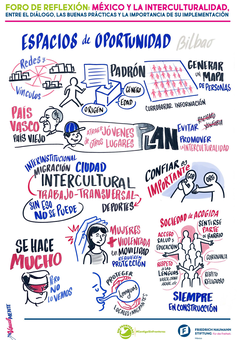Migration
Intercultural Cities: The Future of Integration Policies in Mexico?

The Intercultural Cities program of the Council of Europe supports cities and regions in adapting their policies with an intercultural vision, as well as to develop intercultural strategies that can manage diversity as an asset for society. When speaking about Intercultural Cities as a program, it is important to conceive it as a platform that connects cities and leaders worldwide in a community where the initiatives and good practices of one city are analysed to inspire others. In this sense, cities that are part of such a program can gain from the entrepreneurship, creativity and a wide range of skills associated with the best practices of other cities. Moreover, they can all see diversity as a mechanism for formulating policies that facilitate intercultural interaction and inclusion.
The Intercultural Cities program of the Council of Europe supports cities and regions in adapting their policies with an intercultural vision, as well as to develop intercultural strategies that can manage diversity as an asset for society. When speaking about Intercultural Cities as a program, it is important to conceive it as a platform that connects cities and leaders worldwide in a community where the initiatives and good practices of one city are analysed to inspire others. In this sense, cities that are part of such a program can gain from the entrepreneurship, creativity and a wide range of skills associated with the best practices of other cities. Moreover, they can all see diversity as a mechanism for formulating policies that facilitate intercultural interaction and inclusion.
What is an intercultural city?
An intercultural city is one where equality exists by preventing discrimination and adapting institutional frameworks in favour of plural societies. Furthermore, in an intercultural city, both citizens and political leaders see diversity as a positive resource. Positive interaction between individuals and groups is encouraged through the appropriation of public space and the exchange of dialogue. Active citizenship and general participation promote that even those without citizenship can have a voice in shaping society.
The Council of Europe's Intercultural Cities Program is implemented in more than 130 cities in Europe, Australia, Canada, Japan, Mexico and the United States. The program provides cities with innovative methodologies that help local authorities develop intercultural policies in areas ranging from economic development to urban planning. One example is the anti-rumour strategy that focuses on eliminating the causes of discrimination by identifying and dismantling the diversity bias and rumours that form the basis of discrimination and racist attitudes.
In Latin America, only Mexico City is a member of this program. It is necessary that political leaders and citizens also see diversity as a positive resource. Mexico City has been recognized as an intercultural city because it has a commitment to combat discrimination, in addition to adapting its governance, institutions and services to a diverse population. According to the latest results of the Intercultural Cities Index elaborated in 2014, Mexico City was evaluated number 13 out of 59 cities with an index of 68%. One of the best practices has been the creation of the Council to Prevent and Eliminate Discrimination in Mexico City. The revaluation of the city is still pending, and as such it is a key opportunity to reinforce its role as a leading Latin-American intercultural city.
Could such a model be replicable in other cities in Mexico that are increasingly receiving mobile populations?
This year we visited the cities of Tapachula, a city known for being the gate to Mexico in the southern border with Guatemala, and Tijuana, one of the most important cities located in the northern border of Mexico, just kilometres away from San Diego, California. Each one of these cities has its very specific flows: migration and the situation of people in movement is complex. Our study tours in these cities strived to analyse how viable is the implementation of intercultural models in border cities. Both, Tijuana and Tapachula are in practice already intercultural. However, they face the challenge that many border cities encounter: many people stay there for a short term and look forward to keep on moving. However, in Tapachula and in Tijuana there is already a well stablished community of Haitians who decided to stay in Mexico. The long asylum process and constant changes of migration policies in the Unites States are a reason for many to decide to stay in these cities.
Border cities are characterized by their short-term strategies aiming to control emergencies. In this sense, there is still a long way to go in terms of building the principles of an intercultural city based in equality, commitment to recognize diversity as a resource and regulatory frameworks. This is interesting, because in both cities there is a large deployment of international and civil society organizations. In fact, civil society organizations are increasingly covering aspects that were not previously possible such as supporting HIV screening and providing information for the LGBTI population on the move. The presence of these organizations is vital, as they are the ones that provide attention to the migrants and asylum seekers. However, it is important that both cities begin to move towards an integration agenda beyond the short term. In Tijuana there is greater progress with cultural activities, however, there are many opportunity areas in the institutional framework.
In the case of Monterrey, a city in northern Mexico known as the economic hub of the country, there has been an increase in the arrival of people and, thus the city must move quickly towards an intercultural agenda. It must begin with multilevel governance by coordinating decision making by considering that there already is political will to do so. As in the case of Mexico City, political commitment is required so that these strategies can be translated into regulatory frameworks, and there must be a commitment as a city to develop an intercultural strategy within the framework of urban management.
There is a long way to go
An intercultural city agenda as an integration policy has plenty of potential in Mexico. At FNF Mexico, we consider that one of the best strategies towards the conformation of open and plural societies is the intercultural framework based on the respect of human rights combining the urban approach that and citizen participation. Intercultural cities also offer a medium and long-term strategy towards social and economic integration, so they could be the future of integration policies in Mexico, generating an exchange of best practices and information, as well as a network of experts on the subject, as more cities join these efforts.
Foro de reflexión: México y la interculturalidad, entre el diálogo, las buenas prácticas y la importancia de su implementación
-

Foro de reflexión: México y la interculturalidad, entre el diálogo, las buenas prácticas y la importancia de su implementación
